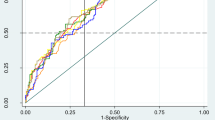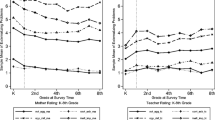Abstract
Kindergarten teacher ratings of physical aggression, hyperactivity,inattention, anxiety, and prosocial behavior were used to predictself-reported delinquency, peer-rated social withdrawal, and schoolplacement in preadolescence (ages 10 to 12 years) in a large longitudinalsample of boys from low socio-economic neighborhoods. Two analyticstrategies were used: person-oriented and variable-oriented approaches. Inthe person approach, eight clusters, based on the kindergarten behaviors,were used to predict delinquency, social withdrawal, and schoolplacement. In the variable approach, the kindergarten behaviors were used asdimensions in logistic regressions. Family adversity was used as the firstpredictor in both approaches; it significantly predicted all the outcomes inpreadolescence. The results obtained using the two approaches were partly inaccordance. In both sets of results, kindergarten teacher-ratedexternalizing behavior problems were most related to later self-reporteddelinquency, and internalizing problems to peer-rated socialwithdrawal. However, the person approach showed that all patterns ofkindergarten behavior problems increased the risk for placement out of anage-appropriate regular classroom, while only inattention and lack ofprosocial behavior were the significant dimensional predictors of thisnegative outcome according to the variable approach. Also, the personapproach showed that the Multiproblem kindergarten boys had the highestpercentage of comorbidity of preadolescent problems. The ROC curvesindicated that prediction of delinquency, social withdrawal, and schoolplacement were equally accurate using the cluster and variableapproaches. Advantages and limits of both approaches are discussed withreference to their usefulness for clinicians.
Similar content being viewed by others
REFERENCES
Achenbach, T. M. (1989). Empirically based assessment of child and adolescent disorders: Implications for diagnosis, classification, epidemiology, and longitudinal research. In Bambring, M., Losel, F. and Skowronek, H. (eds.), Children at Risk: Assessment, Longitudinal Research, and Intervention, Gruyter, Berlin, pp. 24–45.
Behar, L. B., and Stringfield, S. (1974). A behavior rating scale for the preschool child. Devel. Psychol. 10: 601–610.
Blanz, B., Schmidt, M. H., and Esser, G. (1991). Familial adversities and child psychiatric disorders J. Child Psychol. Psych. 32: 939–950.
Cairns, R. B., Cairns, B. D., and Neckerman, H. J. (1988). Early school dropout: Configurations and determinants. Child Devel. 60: 1437–1452.
Cattell, R. B. (1965). The Scientific Analysis of Personality. Aldine, Chicago, IL.
Cicchetti, D. (1990). A historical perspective on the discipline of developmental psychopathology. In Rolf, J., Masten, A., Cicchetti, D., Nuechterlein, K., and Weintraub, S. (eds.), Risk and Protective Factors in the Development of Psychopathology, Cambridge University Press, New York, pp. 2–28.
Dreger, R. M. (1977). The children's Behavioral Classification Project: An interim report. J. Abnor. Child Psychol. 5: 289–297.
Duncan, G. J., Brooks-Gunn, J., and Klebanov, P. K. (1994). Economic deprivation and early childhood development. Child Devel. 65: 196–318.
Egeland, B., Pianta, R., and Ogawa, J. (1996). Early behavior problems: Pathways to mental disorders in adolescence. Devel. Psychopathol. 8: 735–749.
Farrington, D. P. (1994). Childhood, adolescent, and adult features of violent males. In Huesmann, L. R. (ed.), Aggressive Behavior: Current Perspectives, Plenum Press, New York, pp. 215–240.
Farrington, D. P., Gallagher, B., Morley, L., Ledger, R. J., and West, D. J. (1988). Are there any successful men from criminogenic backgrounds? Psych. 51: 116–130.
Farrington, D. P., Loeber, R., and Van Kammen, W. B. (1990). The long term criminal outcomes of conduct problem boys with or without impulsive-inattentive behavior. In Robins, L. N., and Rutter, M. (eds.), Straight and Devious Pathways from Childhood to Adulthood, Cambridge University Press, New York, pp. 62–81.
Harrington, R., Rutter, M., and Fombonne, E. (1996). Developmental pathways in depression: Multiple meanings, antecedents, and endpoints. Devel. Psychopathol. 8: 601–616.
Hart, H. H., Jenkins, R. L., Axelrad, S., and Sperling, P. I. (1943). Multiple factor analysis of traits of delinquent boys. J. Soc. Psychol. 17: 191–201.
Hinde, R. A., and Dennis, A. (1986). Categorizing individuals: An alternative to linear analysis. Inter. J. Behav. Devel. 9: 105–119.
Hinshaw, S. P. (1992). Externalizing behavior problems and academic underachievement in childhood and adolescence. Causal relationships and underlying mechanisms. Psychol. Bull. 111: 127–155.
Huesmann, L. R., Eron, L. D., Lefkowitz, M. M., and Walder, L. O. (1984). Stability of aggression over time and generations. Devel. Psychol. 20(6): 1120–1134.
Kellam, S. G. (1990). Developmental epidemiologic framework for family research on depression and aggression. In Patterson, G. R. (ed.), Depression and Aggression in Family Interaction, Erlbaum, Englewood Cliffs, NJ.
Kellam, S. G., Brown, C. H., Rubin, B. R., and Ensminger, M. E. (1983). Paths leading to teenage psychiatric symptoms and substance use: Developmental epidemiological studies in Woodlawn. In Guze, S. B., Earls, F. J., and Barrett, J. E. (eds.), Childhood Psychopathology and Development, Ravan Press, New York, pp. 17–51.
Kerr, M., Tremblay, R. E., Pagani-Kurtz, L., and Vitaro, F. (1997). Boys' behavioral inhibition and the risk of later delinquency. Arch. Gen. Psychiat. 54: 809–816.
LeBlanc, M., and Tremblay, R. E. (1988). A study of factors associated with the stability of hidden delinquency. Inter. J. Adoles. Youth 1: 269–291.
Lipman, E. L., and Offord, D. R. (1997). Psychosocial morbidity among poor children in Ontario. In Duncan, G., and Brooks-Gunn, J. (eds.), Consequences of Growing Up Poor, Russel Sage Foundation, New York, pp. 239–287.
Lochman, J. E., and Wells, K. C. (1996). A social cognitive intervention with aggressive children: Prevention effects and contextual implementation issues. In Peters, R. D. V., and McMahon, R. J. (eds.), Preventing Childhood Disorders, Substance Abuse and Delinquency, Sage, Thousand Oaks, CA, pp. 111–143.
Loeber, R., and Hay, D. F. (1994). Developmental approaches to aggression and conduct problems. In Rutter, M., and Hay, D. F. (eds.), Development Through Life: A Handbook for Clinicians, Blackwell Scientific Publications, Oxford, pp. 488–516.
Magnusson, D. (1988). Individual Development from an Interactional Perspective: A Longitudinal Study, Erlbaum, Hillsdale, NJ.
Magnusson, D., and Bergman, L. R. (1990). A pattern approach to the study of pathways from childhood to adulthood. In Robins, L. N., and Rutter, M. (eds.), Straight and Devious Pathways from Childhood to Adulthood, Cambridge University Press, New York, pp. 101–116.
Maguin, E., and Loeber, R. (1995). Is poor academic performance a cause of delinquency? In Tonry, M., and Farrington, D. P. (eds.), Building a Safer Society: Strategic Approaches to Crime Prevention, University of Chicago Press, Chicago, IL, p. 146.
McCord, J. (1983). A longitudinal study of aggression and antisocial behavior. In Van Dusen, K. T., and Mednick, S. A. (eds.), Prospective Studies of Crime and Delinquency, Kluwery Nijhoff, Boston, MA, pp. 269–275.
Moffitt, T. E. (1988). Accomodating self-report methods to a low-delinquency culture: A longitudinal study from New Zealand. In Klein, M. W. (ed.), Cross-National Research in Self-Reported Crime and Delinquency, Kluwer, Dordrecht, pp. 43–66.
Moffitt, T. E. (1990). Juvenile delinquency and attention deficit disorder: Developmental trajectories from age 3 to age 15. Child Devel. 61: 893–910.
Nagin, D., and Tremblay, R. E. (1999). Trajectories of boys' physical aggression, and hyperactivity on the path to physically violent and nonviolent juvenile delinquency. Child Devel. 70: 1181–1196.
Pagani-Kurtz, L., Boulerice, B., and Tremblay, R. E. (1997). The influence of poverty on children's classroom placement and behavior problems. In Duncan, G., and Brooks-Gunn, J. (eds.), Consequences of Growing Up Poor, Russel Sage Foundation, New York, pp. 311–339.
Pekarik, E. G., Prinz, R. J., Liebert, D. E., Weintraub, S., and Neale, J. N. (1976). The Pupil Evaluation Inventory. A sociometric technique for assessing children's social behavior. J. Abnor. Child Psychol. 4: 83–97.
Pennington, B. F., and Ozonoff, S. (1996). Executive functions and developmental psychopathology. J. Child Psychol. Psych. 37: 51–87.
Pulkkinen, L., and Tremblay, R. E. (1992). Patterns of boys' social adjustment in two cultures and at different ages: A longitudinal perspective. Inter. J. Behav. Devel. 15(4): 527–553.
Quinton, D., Rutter, M., and Gulliver, L. (1990). Continuities in psychiatric disorders from childhood to adulthood in the children of psychiatric patients. In Robins, L., and Rutter, M. (eds.), Straight and Devious Pathways from Childhood to Adulthood, Cambridge University Press, New York, pp. 259–278.
Rubin, K. H., and Asendorpf, J. B. (1993). Social withdrawal, inhibition, and shyness in childhood: Conceptual and definitional issues. In Rubin, K. H., and Asendorpf, J. B. (eds.), Social Withdrawal, Inhibition, and Shyness in Childhood, Lawrence Erlbaum Associates, Hillsdale, NJ.
Smith, J. R., Brooks-Gunn, J., and Klebanov, P. K. (1997). Consequences of living in poverty for young children's cognitive and verbal ability and early school achievement. In Duncan, G., and Brooks-Gunn, J. (eds.), Consequences of Growing Up Poor, Russel Sage Foundation, New York, pp. 132–189.
Stattin, H., and Magnusson, D. (1989). The role of early aggressive behavior in the frequency, seriousness and types of later crime. J. Consul. Clin. Psychol. 57(6): 710–718.
Stattin, H., and Magnusson, D. (1996). Antisocial development: A holistic approach. Devel. Psychopathol. 8: 617–645.
Swets, J. A. (1986). Indices of discrimination or diagnostic accuracy: Their ROCs and implied models. Psychol. Bull. 99: 100–117.
Toth, S. L., Manly, J. T., and Cicchetti, D. (1992). Child maltreatment and vulnerability to depression. Devel. Psychopathol. 4: 97–112.
Tremblay, R. E., Loeber, R., Gagnon, C., Charlebois, P., Lariveé, S., and LeBlanc, M. (1991a). Disruptive boys with stable and unstable high fighting behavior patterns during junior elementary school. J. Abnor. Child Psychol. 19: 285–300.
Tremblay, R. E., Maâse, B., Perron, D., LeBlanc, M., Schwartzman, A. E., and Ledingham, J. E. (1992). Early disruptive behavior, poor school achievement, delinquent behavior and delinquent personality: Longitudinal analyses. J. Consult. Clin. Psychol. 60: 64–72.
Tremblay, R. E., McCord, J., Boileau, H., Charlebois, P., Gagnon, C., LeBlanc, M., and Lariveé, S. (1991b). Can disruptive boys be helped to become competent? Psychiat. 54: 148–161.
Tremblay, R. E., Pihl, R. O., Vitaro, F., and Dobkin, P. L. (1994). Predicting early onset of male antisocial behavior from preschool behavior. Arch. Gen. Psych. 51: 732–738.
Weir, K., and Duveen, G. (1981). Further development and validation of the prosocial behaviour questionnaire for use by teachers. J. Child Psychol. Psych. 22(4): 357–374.
White, J. L., Moffitt, T. E., Earls, F., Robins, L., and Silva, P. A. (1990). How early can we tell? Predictors of childhood conduct disorder and adolescent delinquency. Criminology 28: 507–533.
Zoccolillo, M., Tremblay, R. E., and Vitaro, F. (1996). DSM-III-R and DSM-III criteria for conduct disorder in pre-adolescent girls: Specific but insensitive. J. Amer. Acad. Child Adoles. Psych. 35(4): 461–470.
Author information
Authors and Affiliations
Rights and permissions
About this article
Cite this article
Haapasalo, J., Tremblay, R.E., Boulerice, B. et al. Relative Advantages of Person- and Variable-Based Approaches for Predicting Problem Behaviors from Kindergarten Assessments. Journal of Quantitative Criminology 16, 145–168 (2000). https://doi.org/10.1023/A:1007512521780
Issue Date:
DOI: https://doi.org/10.1023/A:1007512521780




